Hamish Ivison
Large-Scale Data Selection for Instruction Tuning
Mar 03, 2025Abstract:Selecting high-quality training data from a larger pool is a crucial step when instruction-tuning language models, as carefully curated datasets often produce models that outperform those trained on much larger, noisier datasets. Automated data selection approaches for instruction-tuning are typically tested by selecting small datasets (roughly 10k samples) from small pools (100-200k samples). However, popular deployed instruction-tuned models often train on hundreds of thousands to millions of samples, subsampled from even larger data pools. We present a systematic study of how well data selection methods scale to these settings, selecting up to 2.5M samples from pools of up to 5.8M samples and evaluating across 7 diverse tasks. We show that many recently proposed methods fall short of random selection in this setting (while using more compute), and even decline in performance when given access to larger pools of data to select over. However, we find that a variant of representation-based data selection (RDS+), which uses weighted mean pooling of pretrained LM hidden states, consistently outperforms more complex methods across all settings tested -- all whilst being more compute-efficient. Our findings highlight that the scaling properties of proposed automated selection methods should be more closely examined. We release our code, data, and models at https://github.com/hamishivi/automated-instruction-selection.
TESS 2: A Large-Scale Generalist Diffusion Language Model
Feb 19, 2025Abstract:We introduce TESS 2, a general instruction-following diffusion language model that outperforms contemporary instruction-tuned diffusion models, as well as matches and sometimes exceeds strong autoregressive (AR) models. We train TESS 2 by first adapting a strong AR model via continued pretraining with the usual cross-entropy as diffusion loss, and then performing further instruction tuning. We find that adaptation training as well as the choice of the base model is crucial for training good instruction-following diffusion models. We further propose reward guidance, a novel and modular inference-time guidance procedure to align model outputs without needing to train the underlying model. Finally, we show that TESS 2 further improves with increased inference-time compute, highlighting the utility of diffusion LMs in having fine-grained controllability over the amount of compute used at inference time. Code and models are available at https://github.com/hamishivi/tess-2.
2 OLMo 2 Furious
Dec 31, 2024
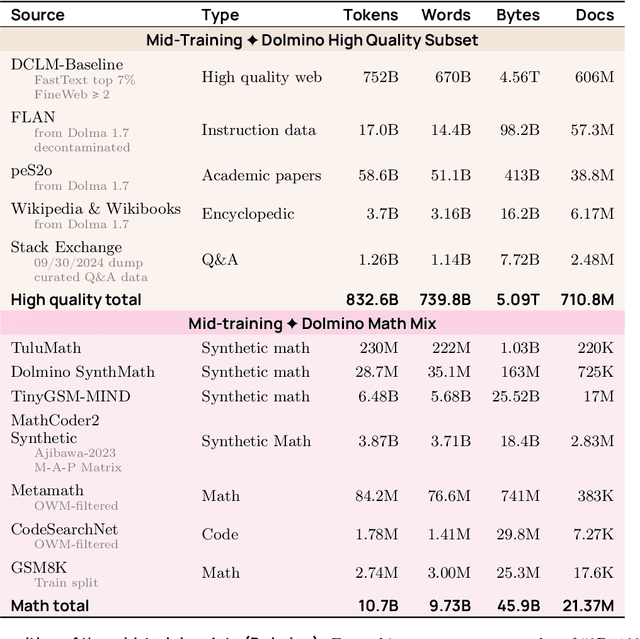
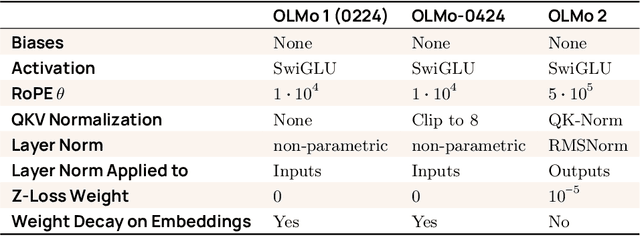

Abstract:We present OLMo 2, the next generation of our fully open language models. OLMo 2 includes dense autoregressive models with improved architecture and training recipe, pretraining data mixtures, and instruction tuning recipes. Our modified model architecture and training recipe achieve both better training stability and improved per-token efficiency. Our updated pretraining data mixture introduces a new, specialized data mix called Dolmino Mix 1124, which significantly improves model capabilities across many downstream task benchmarks when introduced via late-stage curriculum training (i.e. specialized data during the annealing phase of pretraining). Finally, we incorporate best practices from T\"ulu 3 to develop OLMo 2-Instruct, focusing on permissive data and extending our final-stage reinforcement learning with verifiable rewards (RLVR). Our OLMo 2 base models sit at the Pareto frontier of performance to compute, often matching or outperforming open-weight only models like Llama 3.1 and Qwen 2.5 while using fewer FLOPs and with fully transparent training data, code, and recipe. Our fully open OLMo 2-Instruct models are competitive with or surpassing open-weight only models of comparable size, including Qwen 2.5, Llama 3.1 and Gemma 2. We release all OLMo 2 artifacts openly -- models at 7B and 13B scales, both pretrained and post-trained, including their full training data, training code and recipes, training logs and thousands of intermediate checkpoints. The final instruction model is available on the Ai2 Playground as a free research demo.
TÜLU 3: Pushing Frontiers in Open Language Model Post-Training
Nov 22, 2024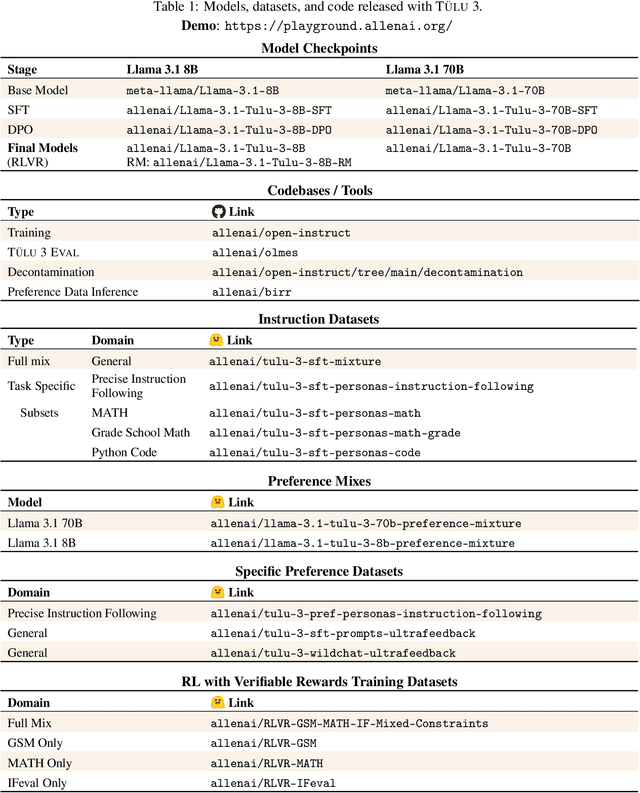



Abstract:Language model post-training is applied to refine behaviors and unlock new skills across a wide range of recent language models, but open recipes for applying these techniques lag behind proprietary ones. The underlying training data and recipes for post-training are simultaneously the most important pieces of the puzzle and the portion with the least transparency. To bridge this gap, we introduce T\"ULU 3, a family of fully-open state-of-the-art post-trained models, alongside its data, code, and training recipes, serving as a comprehensive guide for modern post-training techniques. T\"ULU 3, which builds on Llama 3.1 base models, achieves results surpassing the instruct versions of Llama 3.1, Qwen 2.5, Mistral, and even closed models such as GPT-4o-mini and Claude 3.5-Haiku. The training algorithms for our models include supervised finetuning (SFT), Direct Preference Optimization (DPO), and a novel method we call Reinforcement Learning with Verifiable Rewards (RLVR). With T\"ULU 3, we introduce a multi-task evaluation scheme for post-training recipes with development and unseen evaluations, standard benchmark implementations, and substantial decontamination of existing open datasets on said benchmarks. We conclude with analysis and discussion of training methods that did not reliably improve performance. In addition to the T\"ULU 3 model weights and demo, we release the complete recipe -- including datasets for diverse core skills, a robust toolkit for data curation and evaluation, the training code and infrastructure, and, most importantly, a detailed report for reproducing and further adapting the T\"ULU 3 approach to more domains.
Personalizing Reinforcement Learning from Human Feedback with Variational Preference Learning
Aug 19, 2024Abstract:Reinforcement Learning from Human Feedback (RLHF) is a powerful paradigm for aligning foundation models to human values and preferences. However, current RLHF techniques cannot account for the naturally occurring differences in individual human preferences across a diverse population. When these differences arise, traditional RLHF frameworks simply average over them, leading to inaccurate rewards and poor performance for individual subgroups. To address the need for pluralistic alignment, we develop a class of multimodal RLHF methods. Our proposed techniques are based on a latent variable formulation - inferring a novel user-specific latent and learning reward models and policies conditioned on this latent without additional user-specific data. While conceptually simple, we show that in practice, this reward modeling requires careful algorithmic considerations around model architecture and reward scaling. To empirically validate our proposed technique, we first show that it can provide a way to combat underspecification in simulated control problems, inferring and optimizing user-specific reward functions. Next, we conduct experiments on pluralistic language datasets representing diverse user preferences and demonstrate improved reward function accuracy. We additionally show the benefits of this probabilistic framework in terms of measuring uncertainty, and actively learning user preferences. This work enables learning from diverse populations of users with divergent preferences, an important challenge that naturally occurs in problems from robot learning to foundation model alignment.
Unpacking DPO and PPO: Disentangling Best Practices for Learning from Preference Feedback
Jun 13, 2024Abstract:Learning from preference feedback has emerged as an essential step for improving the generation quality and performance of modern language models (LMs). Despite its widespread use, the way preference-based learning is applied varies wildly, with differing data, learning algorithms, and evaluations used, making disentangling the impact of each aspect difficult. In this work, we identify four core aspects of preference-based learning: preference data, learning algorithm, reward model, and policy training prompts, systematically investigate the impact of these components on downstream model performance, and suggest a recipe for strong learning for preference feedback. Our findings indicate that all aspects are important for performance, with better preference data leading to the largest improvements, followed by the choice of learning algorithm, the use of improved reward models, and finally the use of additional unlabeled prompts for policy training. Notably, PPO outperforms DPO by up to 2.5% in math and 1.2% in general domains. High-quality preference data leads to improvements of up to 8% in instruction following and truthfulness. Despite significant gains of up to 5% in mathematical evaluation when scaling up reward models, we surprisingly observe marginal improvements in other categories. We publicly release the code used for training (https://github.com/hamishivi/EasyLM) and evaluating (https://github.com/allenai/open-instruct) our models, along with the models and datasets themselves (https://huggingface.co/collections/allenai/tulu-v25-suite-66676520fd578080e126f618).
OLMo: Accelerating the Science of Language Models
Feb 07, 2024
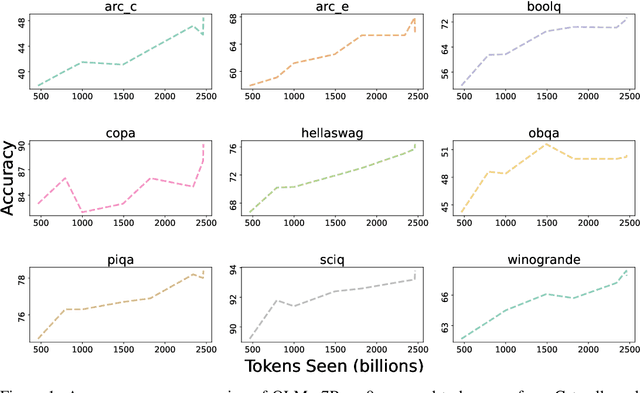
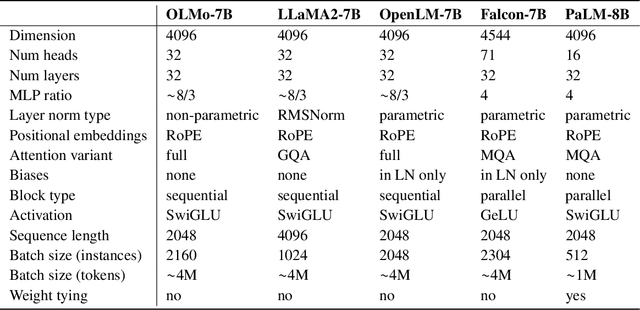
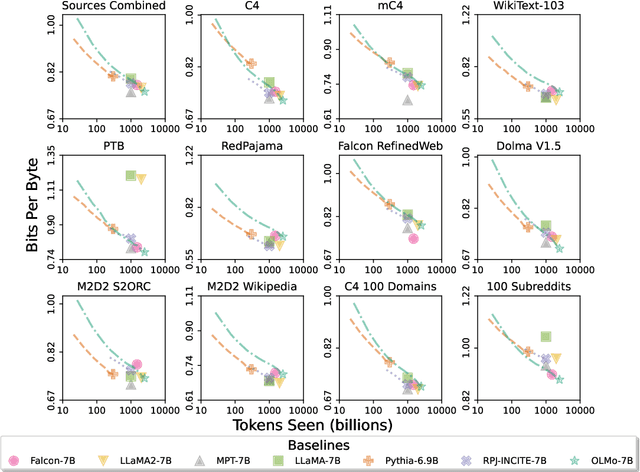
Abstract:Language models (LMs) have become ubiquitous in both NLP research and in commercial product offerings. As their commercial importance has surged, the most powerful models have become closed off, gated behind proprietary interfaces, with important details of their training data, architectures, and development undisclosed. Given the importance of these details in scientifically studying these models, including their biases and potential risks, we believe it is essential for the research community to have access to powerful, truly open LMs. To this end, this technical report details the first release of OLMo, a state-of-the-art, truly Open Language Model and its framework to build and study the science of language modeling. Unlike most prior efforts that have only released model weights and inference code, we release OLMo and the whole framework, including training data and training and evaluation code. We hope this release will empower and strengthen the open research community and inspire a new wave of innovation.
Camels in a Changing Climate: Enhancing LM Adaptation with Tulu 2
Nov 20, 2023Abstract:Since the release of T\"ULU [Wang et al., 2023b], open resources for instruction tuning have developed quickly, from better base models to new finetuning techniques. We test and incorporate a number of these advances into T\"ULU, resulting in T\"ULU 2, a suite of improved T\"ULU models for advancing the understanding and best practices of adapting pretrained language models to downstream tasks and user preferences. Concretely, we release: (1) T\"ULU-V2-mix, an improved collection of high-quality instruction datasets; (2) T\"ULU 2, LLAMA-2 models finetuned on the V2 mixture; (3) T\"ULU 2+DPO, T\"ULU 2 models trained with direct preference optimization (DPO), including the largest DPO-trained model to date (T\"ULU 2+DPO 70B); (4) CODE T\"ULU 2, CODE LLAMA models finetuned on our V2 mix that outperform CODE LLAMA and its instruction-tuned variant, CODE LLAMA-Instruct. Our evaluation from multiple perspectives shows that the T\"ULU 2 suite achieves state-of-the-art performance among open models and matches or exceeds the performance of GPT-3.5-turbo-0301 on several benchmarks. We release all the checkpoints, data, training and evaluation code to facilitate future open efforts on adapting large language models.
How Far Can Camels Go? Exploring the State of Instruction Tuning on Open Resources
Jun 07, 2023Abstract:In this work we explore recent advances in instruction-tuning language models on a range of open instruction-following datasets. Despite recent claims that open models can be on par with state-of-the-art proprietary models, these claims are often accompanied by limited evaluation, making it difficult to compare models across the board and determine the utility of various resources. We provide a large set of instruction-tuned models from 6.7B to 65B parameters in size, trained on 12 instruction datasets ranging from manually curated (e.g., OpenAssistant) to synthetic and distilled (e.g., Alpaca) and systematically evaluate them on their factual knowledge, reasoning, multilinguality, coding, and open-ended instruction following abilities through a collection of automatic, model-based, and human-based metrics. We further introduce T\"ulu, our best performing instruction-tuned model suite finetuned on a combination of high-quality open resources. Our experiments show that different instruction-tuning datasets can uncover or enhance specific skills, while no single dataset (or combination) provides the best performance across all evaluations. Interestingly, we find that model and human preference-based evaluations fail to reflect differences in model capabilities exposed by benchmark-based evaluations, suggesting the need for the type of systemic evaluation performed in this work. Our evaluations show that the best model in any given evaluation reaches on average 83% of ChatGPT performance, and 68% of GPT-4 performance, suggesting that further investment in building better base models and instruction-tuning data is required to close the gap. We release our instruction-tuned models, including a fully finetuned 65B T\"ulu, along with our code, data, and evaluation framework at https://github.com/allenai/open-instruct to facilitate future research.
TESS: Text-to-Text Self-Conditioned Simplex Diffusion
May 15, 2023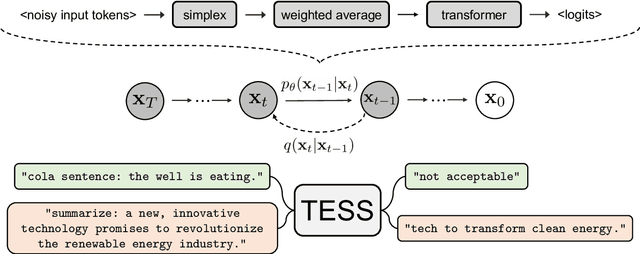
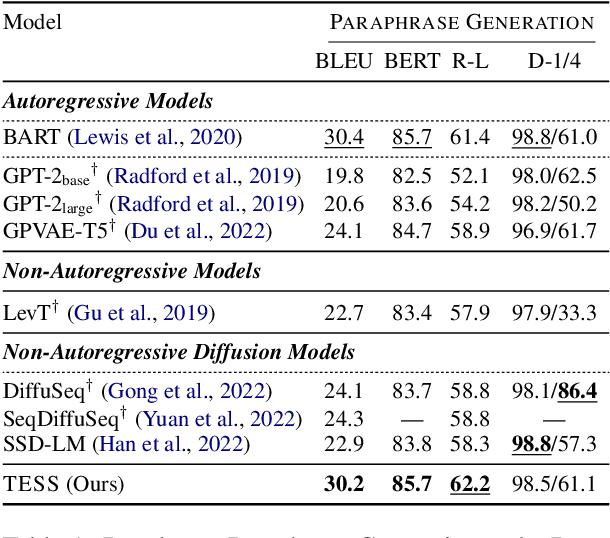

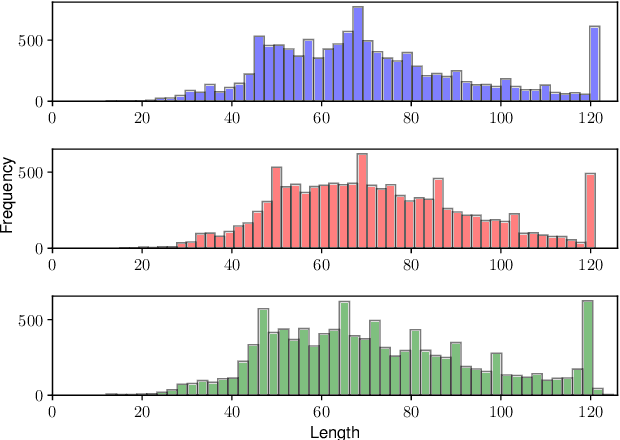
Abstract:Diffusion models have emerged as a powerful paradigm for generation, obtaining strong performance in various domains with continuous-valued inputs. Despite the promises of fully non-autoregressive text generation, applying diffusion models to natural language remains challenging due to its discrete nature. In this work, we propose Text-to-text Self-conditioned Simplex Diffusion (TESS), a text diffusion model that is fully non-autoregressive, employs a new form of self-conditioning, and applies the diffusion process on the logit simplex space rather than the typical learned embedding space. Through extensive experiments on natural language understanding and generation tasks including summarization, text simplification, paraphrase generation, and question generation, we demonstrate that TESS outperforms state-of-the-art non-autoregressive models and is competitive with pretrained autoregressive sequence-to-sequence models.
 Add to Chrome
Add to Chrome Add to Firefox
Add to Firefox Add to Edge
Add to Edge